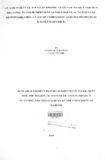| dc.contributor.author | Malonza, Peninah | |
| dc.date.accessioned | 2013-05-10T12:19:06Z | |
| dc.date.available | 2013-05-10T12:19:06Z | |
| dc.date.issued | 2008 | |
| dc.identifier.uri | http://erepository.uonbi.ac.ke:8080/xmlui/handle/123456789/21366 | |
| dc.description.abstract | A number of development programs with a broad goal of empowering the community hardly take into
considerations gender dynamics in their development programs. This trend is observed in policies,
strategies, and plans guiding development work. Kariuki, (1985) strongly argues that, the overall
development of a nation calls for maximum participation of both men and women. The proportion of
women in Kenya, accounts for 51% of the population while the rest are men. This means that of the total
potential human resources available for utilization in national development, women form more than half
(CBS, 2001).
Men and women playa crucial role in child development. This warrants a comprehensive and critical
analysis of their socio-economic status in order to come up with initiatives and strategies to support their
efforts particularly among the poor. Men and women have varying strategic and practical gender needs
by virtue of their different socialized roles. Generally, meeting the practical needs can help improve
beneficiaries' conditions without changing their social status (strategic needs). lt is from this stand point
that this study focuses on assessing the socio-economic status of men and women in compassion assisted
projects in Kaloleni. The result of this study not only be an eye opener to many community based
organizations working in this area but can be applied by .~ any organization interested in women
empowerment in that region. . The target population for this study was 67 representation of larger population of 1449. The research
study aimed at collecting quantitative data using interview with the aid of a questionnaire. Five Projects
within a five kilometre radius as defined by Compassion in Kaloleni were randomly selected. Descriptive
statistics was used as method of analysing data to describe patterns and the distribution of parameters in
the population while inferential statistics was used to test the relationship between selected variables and
to make generalizations.Yfhe percentage of responses was then be calculated and used to make
statements and conclusion | en |
| dc.description.sponsorship | The University of Nairobi | en |
| dc.language.iso | en | en |
| dc.subject | social economic status of women and men | en |
| dc.subject | Kaloleni district. | en |
| dc.title | An assessment of social economic status of women and men relating to their different gender roles, activities and responsibilities; a case of compassion assisted projects in Kaloleni district | en |
| dc.type | Thesis | en |
| local.publisher | Institute of anthropology, gender and African studies | en |

